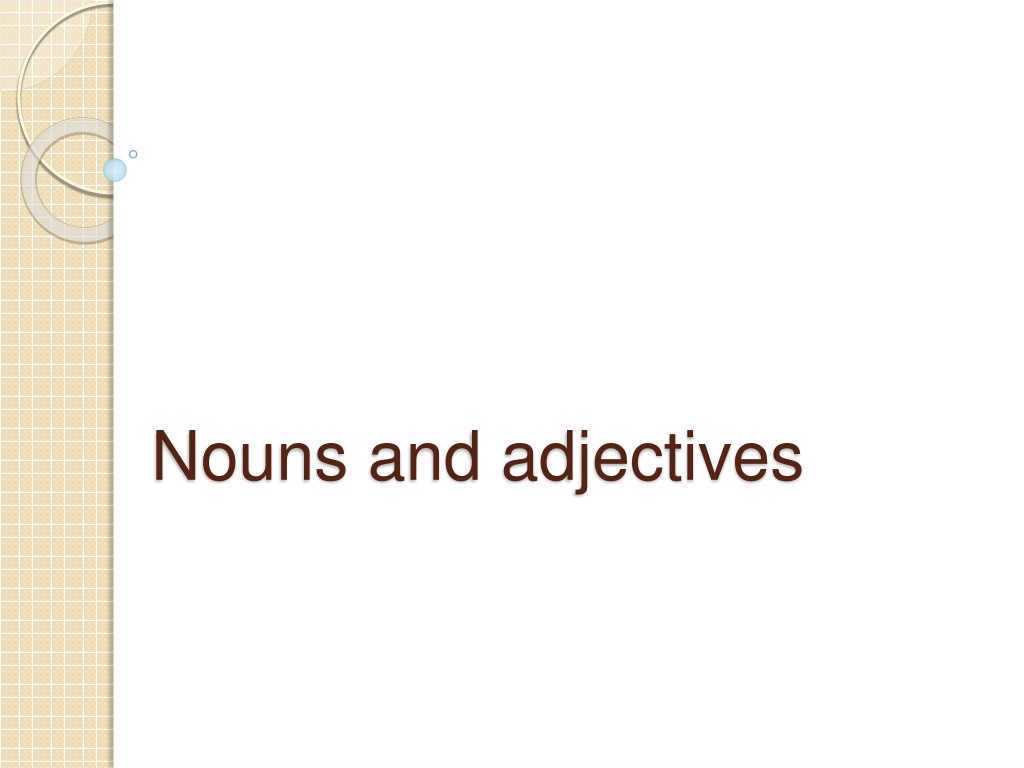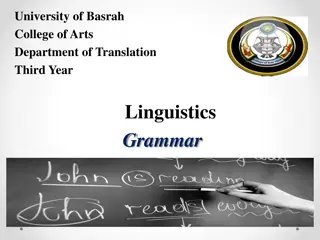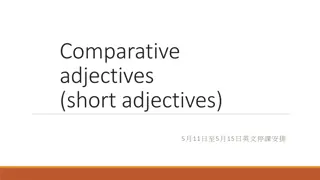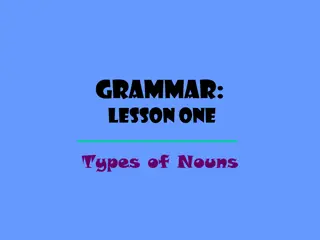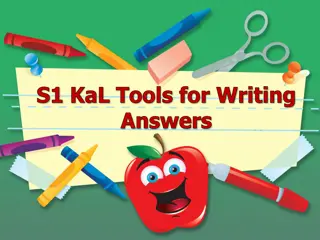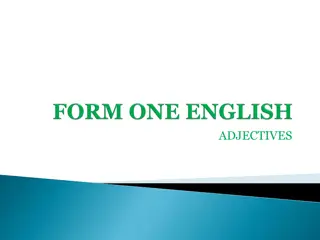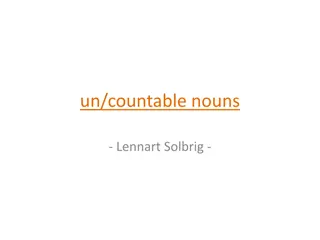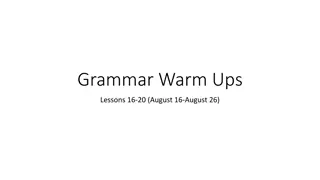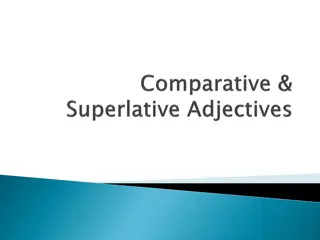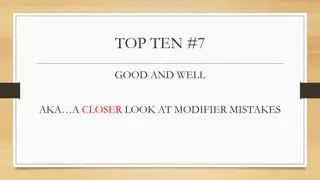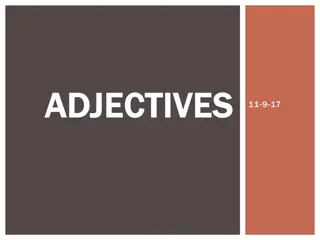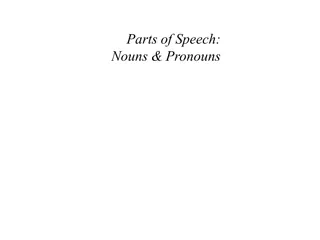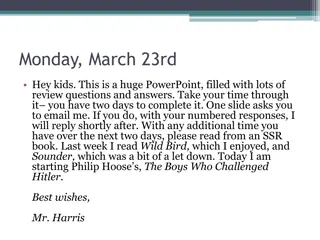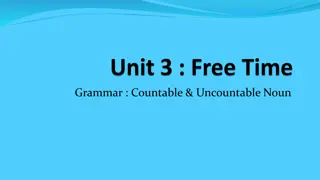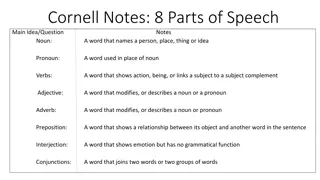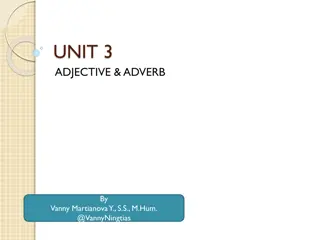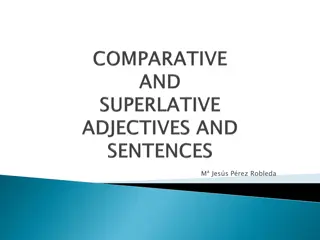Understanding Nouns and Adjectives in Grammar
Exploring the rules and definitions of nouns and adjectives in grammar, this content delves into semantic and linguistic explanations to help students navigate the complexities of differentiating between these parts of speech. It discusses common misconceptions, provides examples, and offers clarity on identifying nouns and adjectives in sentences, making it a valuable resource for language learners.
Download Presentation

Please find below an Image/Link to download the presentation.
The content on the website is provided AS IS for your information and personal use only. It may not be sold, licensed, or shared on other websites without obtaining consent from the author. Download presentation by click this link. If you encounter any issues during the download, it is possible that the publisher has removed the file from their server.
E N D
Presentation Transcript
Grammar Talk T: What are the rules for whether it is a noun or a verb or something else? S1: It s if you can touch it. What is causing the confusion here ? S2: Can you touch it? S3: Can you go to it? T: Can you touch hockey? But hockey is a noun. S4: You play hockey so it must be a doing word. T: Is her a noun? Is this kind of talk helpful ? What would you have said ? S1: Yes, you can touch her. T: Can safe be a noun? S1: Safe is a feeling not a thing. What might you do next ?
Defining nouns and adjectives Common semantic definitions: A noun is a naming word; A noun is a person, place or thing; A noun is something you can see or touch; An adjective is a describing word An adjective goes with a noun These definitions can be misleading for students: It can be difficult to identify nouns that aren t obviously names or things , for instance abstract ideas such as curiosity, happiness, ideas. Describing is a vague function that can be applied to different word classes or even sentence types: as a Y8 student said, If you think about it, all words are descriptive. Adjectives often are found with nouns, but can also follow a verb, in the complement slot in a sentence: Hockey is exciting.
Defining nouns and adjectives It s also easy for students to confuse semantic definitions they have heard. Can you suggest what might have caused confusion for these students: A noun is like saying what a thing is (Y4) I think a noun is the name in words, my name is a noun and I m a noun (Y4) A noun like describes something like a place or a thing or an object (Y5) A noun is the what the sentence is really about (Y7) Is a noun a doing word? (Y7) An adjective is telling you like what to do and stuff like that (Y5) Adjective is when you have ing on the end, like lying (Y7) An adjective adds more information to the sentence (Y8)
Definitions Linguistic definitions Nouns are likely to have one or more of the following features: They can be singular or plural; They can be preceded by a determiner (eg the, a, an, many, few, his, my, this, those); They can be the subject in a sentence They can be the object in a sentence They can be substituted with a pronoun They can be the head of a noun phrase Practise using the definitions above to locate all the nouns in the following: I found him in the garage on a Sunday afternoon. The winter was ending. He was lying there in the darkness behind the tea chests, in the dust and dirt.
Definitions Linguistic definitions: Nouns have one or more of the following features: They can be singular or plural: garage(s); afternoon(s); winter(s); tea chest(s) but darkness, dust, dirt in singular form They can be preceded by a determiner: the garage; the winter; the darkness; the tea chests; the dust; the dirt They can be the subject in a sentence: the winter They can be the object in a sentence: not exemplified: I found him = object pronoun but could be I found the creature They can be substituted with a pronoun: I; he, him They can be the head of a noun phrase: a Sunday afternoon ; the darkness behind the tea chests I found him in the garage on a Sunday afternoon. The winter was ending. He was lying there in the darkness behind the tea chests, in the dust and dirt.
Classifying nouns - sort the nouns on the right under the headings on the left: garage darkness tea chest winter Sunday Falconer Road dust dirt garden truth estate agent proper noun common noun concrete noun abstract noun compound noun count noun non-count noun NB Some words may belong in more than one category
Classifying nouns: proper noun: specific names of people, places, days of the week etc. characterised by use of capital letters: Sunday, Falconer Road All common nouns can be either count or non-count nouns: garage, garden, tea chest, estate agent are individual countable entities that can therefore be plural. When they are singular, count nouns are usually preceded by a determiner. Non-count nouns refer to an undifferentiated entity or concept, such as darkness, dirt, truth and may be used without a determiner. concrete nouns are visible and measurable, as are all the above nouns abstract nouns representingunobservable entities or concepts; many non- count nouns also fall into this category: e.g. truth. Darkness and winter could be classified as concrete or abstract, largely according to context, including figurative or literal use eg Now is the winter of our discontent ; For meteorologists Winter starts on 1st December and ends on 28 February. compound nouns have a meaning that is different or more specific than that of the two separate nouns, as with tea chest; estate agent. Many compound nouns are in such common use that we cease to recognise them as such e.g. football, toothbrush, and are written as one word; otherwise there is no clear rule as to whether they are shown as two words, a single word or are hyphenated.
Forming nouns with suffixes: Understanding how suffixes can form nouns can help students identify nouns and build vocabulary. Some typical patterns are shown below: Abstract nouns - age shortage, mileage, marriage - dom freedom, martyrdom, boredom - hood childhood, neighbourhood, likelihood - ism racism, idealism, fanaticism - ity enmity, individuality, identity - ness loneliness, sadness, forgiveness - ise/ice expertise, cowardice, justice Concrete nouns - ant contestant, participant, celebrant - er waiter, footballer, singer - ess actress, waitress, lioness - ist artist, activist, anthropologist - or actor, survivor, surveyor
Collocations and compound nouns One aspect of vocabulary building is to consider typical collocations that form the technical vocabulary for a topic: these are words that go together to form a distinct entity. Collocations are often adjective + noun or noun + noun, for example: global warming greenhouse gases climate change fatty acids life cycle blood pressure
Adjectives and nouns for description Students often think that they can make their writing more descriptive by adding adjectives . Putting adjective(s) before the head noun (pre- modification) is the simplest way of forming a noun phrase, for example: A squat grey building of only thirty-four storeys. Stone led us down the garden, tugged the door open and shone his little torch into the gloom. He looked at me with a stupid grin on his face. Even here, some of the descriptive work is done by determiners: his little torch; a stupid grin, while prepositional phrases create descriptive precision: a building of only thirty-four storeys; the darkness behind the tea chests. Often, the nouns themselves create the description: shone his little torch into the gloom. He was lying there in the darkness in the dust and dirt The place stank of rot and dust. It is helpful for students to see adjective + noun combinations as one choice in descriptive writing, and to build a repertoire of ways of making writing descriptive.
Adjectives as complements Adjectives can be used to complete a clause, as here: He was filthy and pale and dried out and I thought he was dead. Students who think of adjectives as words that are placed before the noun might be confused into thinking that was dead is a verb phrase. How could you help them see that dead is an adjective in this instance? Complements are very often adjectives that complete the meaning of a be or have verb when it is used as a main verb rather than auxiliary verb: The winter was ending; He was lying there: was = auxiliary verb; ending and lying are part of the verb phrase The baby was ill; We were afraid: was = main verb; ill and afraid are adjective complements.
Suffixes to create adjectives Adjectives: There are several suffixes which create adjectives from other word classes, and which can be taught as part of vocabulary building, for example: -al comical, fanatical -ic phobic, graphic -able comfortable, fashionable - ing glittering, sparkling -ive attractive, festive -y muddy, fatty
Using knowledge of nouns and adjectives: classroom examples
Proper nouns for characterisation Focusing on authors choices of proper nouns to create character, e.g: the names of the giants in Roald Dahl s The BFG. What do we imagine/visualise about the giants from these names? Butcher Boy, Bloodbottler, Maidmasher, Gizzardgulper; Meatdripper, Childchewer, Manhugger, Bonecruncher, Fleshlumpeater. Other examples: Mr and Mrs Dursley, of number four, Privet Drive, were proud to say that they were perfectly normal, thank you very much. They were the last people you d expect to be involved in anything strange or mysterious, because they just didn t hold with such things. (J.K. Rowling) Oh! But he was a tight-fisted hand at the grind-stone, Scrooge! a squeezing, wrenching, grasping, scraping, clutching, covetous, old sinner! (Charles Dickens) Try generating a list of names for teachers and a name for the school they teach in. What do you want your reader to imagine/visualise about them from your choice of proper nouns?
Poems with compound nouns: kennings Thought-Catcher Talk-Monitor Register-Taker Power-Tripper Grade-Maker Coffee-Drinker Card-Player Bad-Dresser Sweet-Talker Life-Saver Laughter-Giver Kristin Hammett A bird-dresser a wind-presser a pillow-filler a poet-quiller an arrow-aimer a dust tamer a cobweb-breaker a tickle-maker Tony Mitton
Abstract and concrete nouns in charity campaigns and political speeches Investigate the balance and contrast between concrete and abstract nouns in charity campaign literature, political speeches and manifestos. What work is done by the different types of nouns? Examples: Imagine a political system that puts the public first. Imagine an economy that gives everyone their fair share. Imagine a society capable of supporting everyone s needs. Imagine a planet protected from the threat of climate change now and for the generations to come. That s the world we want to create and we believe we have the means to do it. (Green Party Manifesto) One child waking up homeless on Christmas morning is a tragedy. 80,000 of them is a disgrace. Our helpline will be open throughout Christmas - helping children like Amy find proper homes. (Shelter)
Noun and adjective choices for establishing setting and genre A squat grey building of only thirty-four storeys. Over the main entrance the words, CENTRAL LONDON HATCHERY AND CONDITIONING CENTRE, and, in a shield, the World State's motto, COMMUNITY, IDENTITY, STABILITY. Aldous Huxley, Brave New World The focus is on noun choices because there are no verbs in these two opening sentences to Huxley s dystopian novel. What picture is created through the choice of adjectives? What do you notice about the choice of abstract nouns in the motto? What is both normal and abnormal in the choice of concrete nouns describing the building s function? What view of society is given to us through these choices? Would you want to live in this society?
Other contexts for a focus on nouns Choosing appropriate technical vocabulary in order to sound like an expert in a non-fiction text, e.g. life cycle; chrysalis; metamorphosis; larvae Choosing appropriate vocabulary for historical authenticity in a fictional narrative, e.g. trenches; bayonet; rifle; no-man s-land; puttees; trenchfoot; desertion; officer; private Choosing synonyms for nouns to avoid repetition and to create cohesion in an argument or information text, e.g. young people; school students; pupils; learners; youth youngsters; teenagers; juveniles; adolescents; minors.
Noun and adjective choices for description: analysing the author s craft Adjectives: Nouns: hot; sour; open; animal; tiger; night; breath; stench; long; slow; distant; huge; pelt; odour; streets; window; glittering; cruel; hot; harsh; dreams; wildness; tongue; wide open; curved nostrils; tiger; footpads; stairs; breath; sighing; lungs; rattle; These are the nouns and adjectives used in an extract from Secret Heart by David Almond. What do you think is being described? Are you surprised that there are more nouns than adjectives? What might puzzle students about the highlighted words? throat; bedroom; head; eyes; tongue; sandpaper; arm; mouth; teeth; tiger
The tiger padded through the night. Joe Maloney smelt it, the hot, sour breath, the stench of its pelt. The odour crept through the streets, through his open window and into his dreams. He felt the animal wildness on his tongue, in his nostrils. The tiger moved as if it knew him, as if it was drawn to him. Joe heard its footpads on the stairs. He heard its long slow breath, the distant sighing in its lungs, the rattle in its throat. It came inside. It filled the bedroom. The huge head hung over him. The glittering cruel eyes stared into him. The hot tongue, harsh as sandpaper, licked his arm. The mouth was wide open, the curved teeth were poised to close on him. He prepared to die. Then someone somewhere called: Tiger! Tiger! Tiger! Tiger! From Secret Heart by David Almond Explain why the underlined blue words are adjectives and the underlined red words are nouns. How can you be sure?
Creating nouns from adjectives Joe Maloney smelt it, the heat and sourness of its breath, the stench of its pelt The tiger padded through the night. Joe Maloney smelt it, the hot, sour breath, the stench of its pelt. The odour crept through the streets, through his open window and into his dreams. He felt the animal wildness on his tongue, in his nostrils. The tiger moved as if it knew him, as if it was drawn to him. Joe heard its footpads on the stairs. He heard its long slow breath, the distant sighing in its lungs, the rattle in its throat. It came inside. It filled the bedroom. The huge head hung over him. The glittering cruel eyes stared into him. The hot tongue, harsh as sandpaper, licked his arm. The mouth was wide open, the curved teeth were poised to close on him. He prepared to die. Then someone somewhere called: Tiger! Tiger! Tiger! Tiger! And it was gone. 22
ing words: present participles the distant sighing in its lungs (noun) The glittering cruel eyes stared into him (adjective) Present participles can be different word classes, depending on how they are used in a sentence. They can be: A noun An adjective A verb
Grammar Talk: what more can you say now? T: What are the rules for whether it is a noun or a verb or something else? S: It s if you can touch it. What is causing the confusion here ? S: Can you touch it? S: Can you go to it? T: Can you touch hockey? But hockey is a noun. S: You play hockey so it must be a doing word. T: Is her a noun? Is this kind of talk helpful ? What would you have said ? S: Yes, you can touch her. T: Can safe be a noun? What might you do next ? S: Safe is a feeling not a thing.
